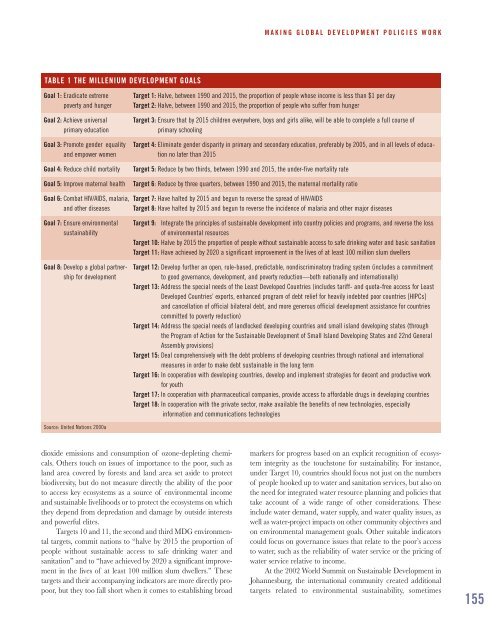jp8589 WRI.qxd - World Resources Institute
jp8589 WRI.qxd - World Resources Institute
jp8589 WRI.qxd - World Resources Institute
Create successful ePaper yourself
Turn your PDF publications into a flip-book with our unique Google optimized e-Paper software.
MAKING GLOBAL DEVELOPMENT POLICIES WORK<br />
TABLE 1 THE MILLENIUM DEVELOPMENT GOALS<br />
Goal 1: Eradicate extreme<br />
poverty and hunger<br />
Goal 2: Achieve universal<br />
primary education<br />
Goal 3: Promote gender equality<br />
and empower women<br />
Goal 4: Reduce child mortality<br />
Goal 5: Improve maternal health<br />
Target 1: Halve, between 1990 and 2015, the proportion of people whose income is less than $1 per day<br />
Target 2: Halve, between 1990 and 2015, the proportion of people who suffer from hunger<br />
Target 3: Ensure that by 2015 children everywhere, boys and girls alike, will be able to complete a full course of<br />
primary schooling<br />
Target 4: Eliminate gender disparity in primary and secondary education, preferably by 2005, and in all levels of education<br />
no later than 2015<br />
Target 5: Reduce by two thirds, between 1990 and 2015, the under-five mortality rate<br />
Target 6: Reduce by three quarters, between 1990 and 2015, the maternal mortality ratio<br />
Goal 6: Combat HIV/AIDS, malaria,<br />
and other diseases<br />
Target 7: Have halted by 2015 and begun to reverse the spread of HIV/AIDS<br />
Target 8: Have halted by 2015 and begun to reverse the incidence of malaria and other major diseases<br />
Goal 7: Ensure environmental<br />
sustainability<br />
Goal 8: Develop a global partnership<br />
for development<br />
Target 9: Integrate the principles of sustainable development into country policies and programs, and reverse the loss<br />
of environmental resources<br />
Target 10: Halve by 2015 the proportion of people without sustainable access to safe drinking water and basic sanitation<br />
Target 11: Have achieved by 2020 a significant improvement in the lives of at least 100 million slum dwellers<br />
Target 12: Develop further an open, rule-based, predictable, nondiscriminatory trading system (includes a commitment<br />
to good governance, development, and poverty reduction—both nationally and internationally)<br />
Target 13: Address the special needs of the Least Developed Countries (includes tariff- and quota-free access for Least<br />
Developed Countries’ exports, enhanced program of debt relief for heavily indebted poor countries [HIPCs]<br />
and cancellation of official bilateral debt, and more generous official development assistance for countries<br />
committed to poverty reduction)<br />
Target 14: Address the special needs of landlocked developing countries and small island developing states (through<br />
the Program of Action for the Sustainable Development of Small Island Developing States and 22nd General<br />
Assembly provisions)<br />
Target 15: Deal comprehensively with the debt problems of developing countries through national and international<br />
measures in order to make debt sustainable in the long term<br />
Target 16: In cooperation with developing countries, develop and implement strategies for decent and productive work<br />
for youth<br />
Target 17: In cooperation with pharmaceutical companies, provide access to affordable drugs in developing countries<br />
Target 18: In cooperation with the private sector, make available the benefits of new technologies, especially<br />
information and communications technologies<br />
Source: United Nations 2000a<br />
dioxide emissions and consumption of ozone-depleting chemicals.<br />
Others touch on issues of importance to the poor, such as<br />
land area covered by forests and land area set aside to protect<br />
biodiversity, but do not measure directly the ability of the poor<br />
to access key ecosystems as a source of environmental income<br />
and sustainable livelihoods or to protect the ecosystems on which<br />
they depend from depredation and damage by outside interests<br />
and powerful elites.<br />
Targets 10 and 11, the second and third MDG environmental<br />
targets, commit nations to “halve by 2015 the proportion of<br />
people without sustainable access to safe drinking water and<br />
sanitation” and to “have achieved by 2020 a significant improvement<br />
in the lives of at least 100 million slum dwellers.” These<br />
targets and their accompanying indicators are more directly propoor,<br />
but they too fall short when it comes to establishing broad<br />
markers for progress based on an explicit recognition of ecosystem<br />
integrity as the touchstone for sustainability. For instance,<br />
under Target 10, countries should focus not just on the numbers<br />
of people hooked up to water and sanitation services, but also on<br />
the need for integrated water resource planning and policies that<br />
take account of a wide range of other considerations. These<br />
include water demand, water supply, and water quality issues, as<br />
well as water-project impacts on other community objectives and<br />
on environmental management goals. Other suitable indicators<br />
could focus on governance issues that relate to the poor’s access<br />
to water, such as the reliability of water service or the pricing of<br />
water service relative to income.<br />
At the 2002 <strong>World</strong> Summit on Sustainable Development in<br />
Johannesburg, the international community created additional<br />
targets related to environmental sustainability, sometimes<br />
155

















